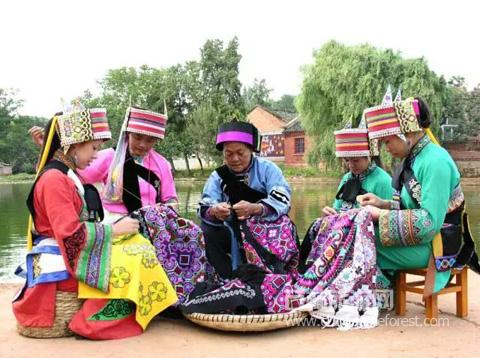
In the hometown of Ashima, every girl who enters adulthood
has a beautiful colorful kerchief. Whether on a path in Stone Forest, or at the village entrance by Long Lake; whether in the
field at the foot of Gui Mountain or in the shade beside Dadieshui Waterfall, as long as this is a place for Sani
people's settlement, you can see Sani girls’ colorful kerchief everywhere.

During
celebration, going out, or festivals, Sani girls will put on new ethnical
costumes and dress up carefully. They spend the most time on kerchief. The colorful kerchief hairstyle looks very beautiful but
takes quite a while as there are altogether seven or eight procedures. First,
arrange long hair into a high knot while leaving some hair from it. Then, put on a
pin which is made of a wood chip about five centimeters wide in the horseshoe
shape wrapped in cloth. Put it in the hair with its bend backward, and wrap the
hanging hair on it. Then, wrap it and fix it around the head with a piece of
long cloth called Edumo, and put on milky white beads. Next, add colorful kerchief
cloth on the outer layer, and put on two triangular "butterflies" one
after the other. Finally, wrap an anti-slipping knot so that the entire
decoration is firm and will not collapse no matter how the head moves or shakes. The whole process
of Sani girls’ making a colorful kerchief hairstyle is really dazzling but well
organized and orderly. Such a process takes dozens of minutes!

Sani girls cherish their colorful kerchief so much
because this decoration gives them beautiful appearance. However, there is
a further reason
- a moving
story which brings them the most beautiful pursuit in their mind - love and
marriage.
Sani
people have a legend about "Gui Mountain rainbow".
According
to legend, there are 120 rainbows in the world and the largest and most
beautiful one is Gui Mountain rainbow above Sani people’s residence. How did
this rainbow come from? According to legend, in the ancient times there was a smart girl named Awaruozi and a
handsome and brave young man named Budaruoshu. The two of them grew up in
misery and loved each other at work, but their love was destroyed by hereditary
headman. Hereditary headman
wanted to marry Awaruozi. Proud of his wealth, he prepared 33 cattle, 55 rolls of cloth, 77 jars of liquor, and 999 bags of shell
currency to exchange for her. However, Awaruozi was not interested in these
and she still firmly loved Budaruoshu. Vicious hereditary headman decided to kill Budaruoshu and then sent
people to kidnap Awaruozi. When hereditary headman ordered people to light
firewood to burn Budaruoshu, loyal
Awaruozi broke free
from the guards and jumped into the fire. Hereditary headman was so angry that
he ordered to burn them separately; however, their smoke directly changed into
colorful clouds and mixed together. Seeing this, hereditary headman went
raging. He ordered people to set 9 piles of fires, intending to disperse the
colorful cloud with thick smoke. At this time, there was a sudden gust of wind with pouring rain, a torrent came and
washed the headman away. After the rain stopped, there were two rainbows in the sky. Sani people said: the
strong one was the beautiful girl Awaruozi; and the light one was the brave
young man Budaruoshu. Since then, Sani girls have embroidered five colored
strips on kerchief to symbolize the rainbows formed by Awaruozi and Budaruoshu.
This
beautiful legend makes Sani girls’ colorful kerchief more beautiful and poetic,
so it is not difficult to understand why they regard it as valuable as life.
Colorful kerchief is their pride, containing their ideals and wishes to pursue
free love and happiness.
In the
hometown of Ashima, colorful kerchiefs of thousands of Sani girls decorate
happy life like a beautiful rainbows and blossoming flowers. No one else will
have such a colorful kerchief in addition to Sani girls!
(Text from
online)
![]() No. 53012602000141, Anne, Yunnan Public Network
No. 53012602000141, Anne, Yunnan Public Network


